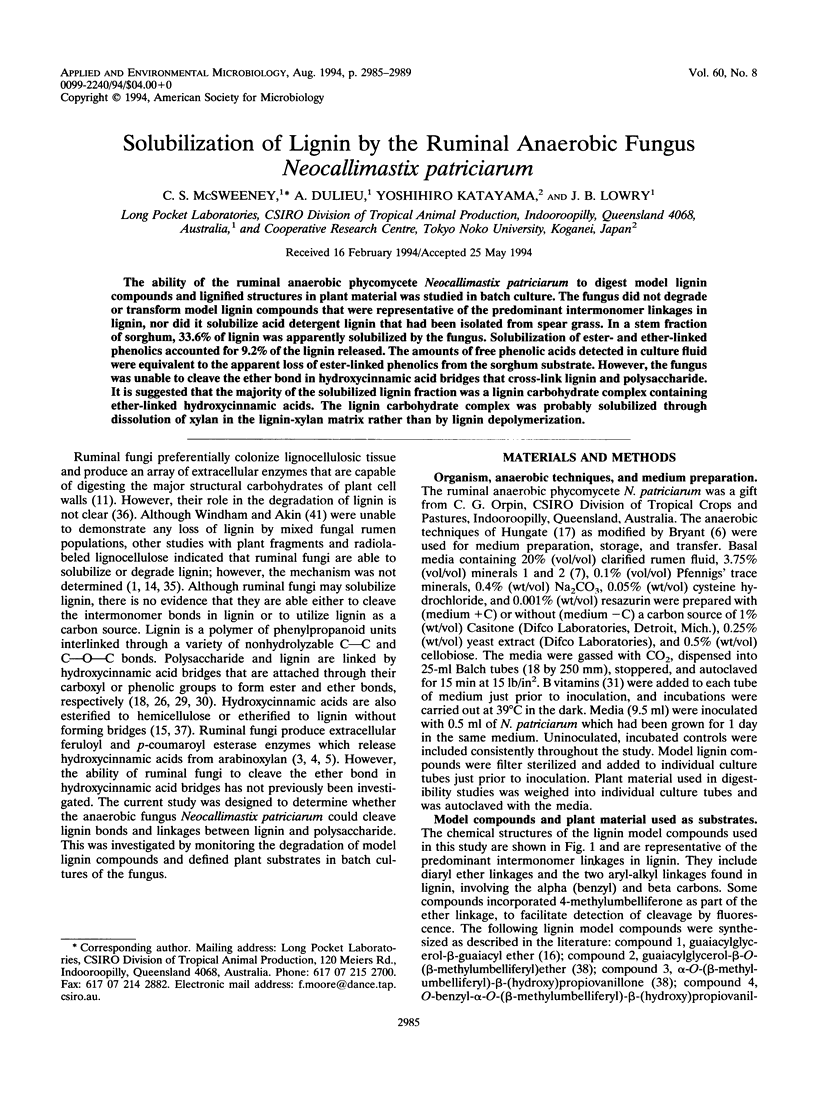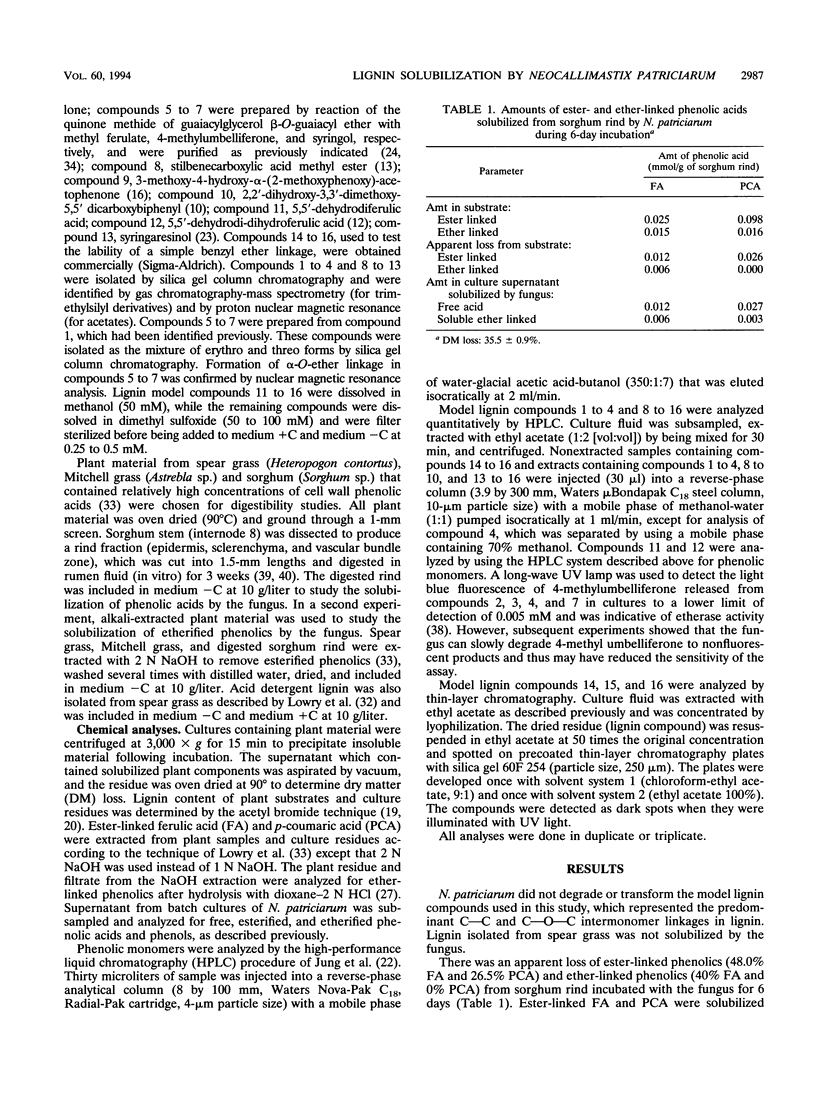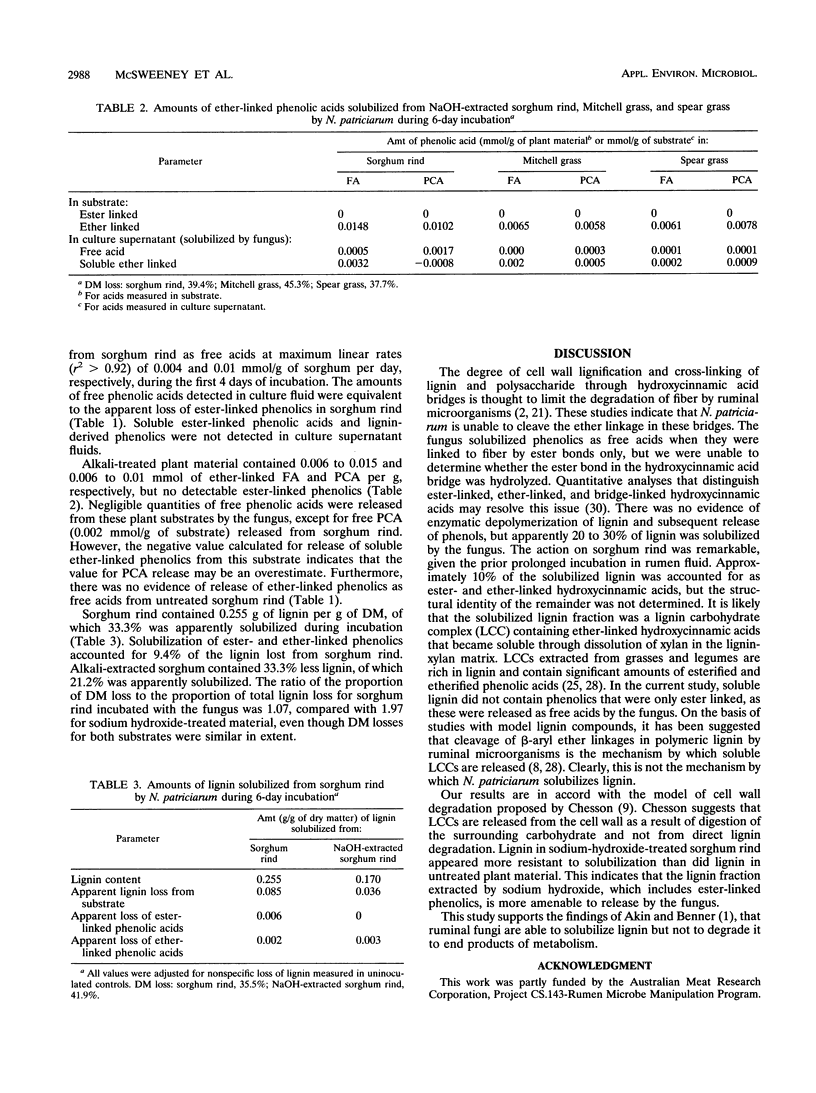Abstract
The ability of the ruminal anaerobic phycomycete Neocallimastix patriciarum to digest model lignin compounds and lignified structures in plant material was studied in batch culture. The fungus did not degrade or transform model lignin compounds that were representative of the predominant intermonomer linkages in lignin, nor did it solubilize acid detergent lignin that had been isolated from spear grass. In a stem fraction of sorghum, 33.6% of lignin was apparently solubilized by the fungus. Solubilization of ester- and either-linked phenolics accounted for 9.2% of the lignin released. The amounts of free phenolic acids detected in culture fluid were equivalent to the apparent loss of ester-linked phenolics from the sorghum substrate. However, the fungus was unable to cleave the ether bond in hydroxycinnamic acid bridges that cross-link lignin and polysaccharide. It is suggested that the majority of the solubilized lignin fraction was a lignin carbohydrate complex containing ether-linked hydroxycinnamic acids. The lignin carbohydrate complex was probably solubilized through dissolution of xylan in the lignin-xylan matrix rather than by lignin depolymerization.
Full text
PDF




Selected References
These references are in PubMed. This may not be the complete list of references from this article.
- Akin D. E., Benner R. Degradation of polysaccharides and lignin by ruminal bacteria and fungi. Appl Environ Microbiol. 1988 May;54(5):1117–1125. doi: 10.1128/aem.54.5.1117-1125.1988. [DOI] [PMC free article] [PubMed] [Google Scholar]
- Borneman W. S., Ljungdahl L. G., Hartley R. D., Akin D. E. Isolation and characterization of p-coumaroyl esterase from the anaerobic fungus Neocallimastix strain MC-2. Appl Environ Microbiol. 1991 Aug;57(8):2337–2344. doi: 10.1128/aem.57.8.2337-2344.1991. [DOI] [PMC free article] [PubMed] [Google Scholar]
- Borneman W. S., Ljungdahl L. G., Hartley R. D., Akin D. E. Purification and partial characterization of two feruloyl esterases from the anaerobic fungus Neocallimastix strain MC-2. Appl Environ Microbiol. 1992 Nov;58(11):3762–3766. doi: 10.1128/aem.58.11.3762-3766.1992. [DOI] [PMC free article] [PubMed] [Google Scholar]
- Bryant M. P. Commentary on the Hungate technique for culture of anaerobic bacteria. Am J Clin Nutr. 1972 Dec;25(12):1324–1328. doi: 10.1093/ajcn/25.12.1324. [DOI] [PubMed] [Google Scholar]
- Caldwell D. R., Bryant M. P. Medium without rumen fluid for nonselective enumeration and isolation of rumen bacteria. Appl Microbiol. 1966 Sep;14(5):794–801. doi: 10.1128/am.14.5.794-801.1966. [DOI] [PMC free article] [PubMed] [Google Scholar]
- Chen W., Supanwong K., Ohmiya K., Shimizu S., Kawakami H. Anaerobic degradation of veratrylglycerol-beta-guaiacyl ether and guaiacoxyacetic acid by mixed rumen bacteria. Appl Environ Microbiol. 1985 Dec;50(6):1451–1456. doi: 10.1128/aem.50.6.1451-1456.1985. [DOI] [PMC free article] [PubMed] [Google Scholar]
- Makino M., Davidson W. F., Fredrickson T. N., Hartley J. W., Morse H. C., 3rd Effects of non-MHC loci on resistance to retrovirus-induced immunodeficiency in mice. Immunogenetics. 1991;33(5-6):345–351. doi: 10.1007/BF00216693. [DOI] [PubMed] [Google Scholar]
- Masai E., Katayama Y., Nishikawa S., Yamasaki M., Morohoshi N., Haraguchi T. Detection and localization of a new enzyme catalyzing the beta-aryl ether cleavage in the soil bacterium (Pseudomonas paucimobilis SYK-6). FEBS Lett. 1989 Jun 5;249(2):348–352. doi: 10.1016/0014-5793(89)80656-8. [DOI] [PubMed] [Google Scholar]
- Windham W. R., Akin D. E. Rumen fungi and forage fiber degradation. Appl Environ Microbiol. 1984 Sep;48(3):473–476. doi: 10.1128/aem.48.3.473-476.1984. [DOI] [PMC free article] [PubMed] [Google Scholar]


